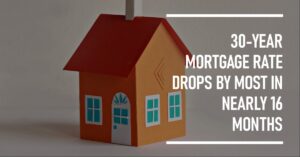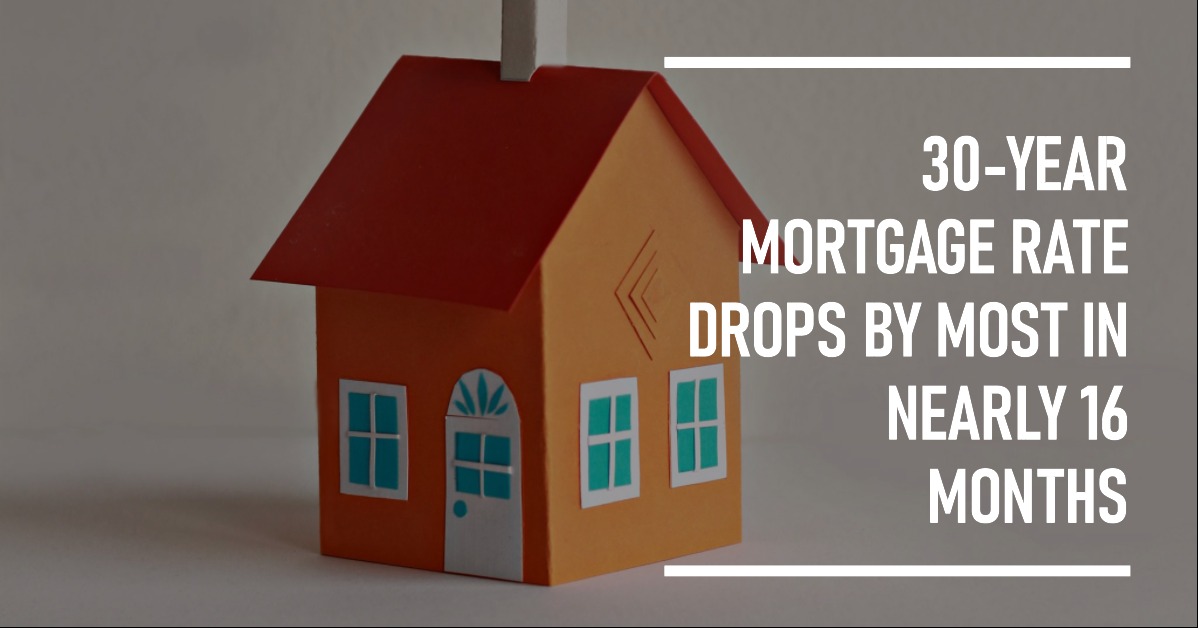Yes, you read that right. Mortgage rates have dipped below the 7% mark, offering a small glimmer of hope to those of us who've been watching the housing market with bated breath. For the first time in what feels like an eternity, the average 30-year fixed mortgage rate has edged down, providing a much-needed breath of fresh air. But before you start packing your boxes, it’s crucial to understand that this is not a sweeping victory; it’s more like a cautious step in the right direction. We’re not suddenly back in the days of ridiculously low rates, and the market still has significant hurdles to overcome.
30-Year Mortgage Rate Falls Below 7% to Close January 2025
I’ve been keeping a close eye on the housing market for years, and I can tell you that the climb we’ve seen in mortgage rates has been nothing short of disheartening for many. The shift from those record low rates to the current levels has been quite dramatic. This is a tricky time, and I'm seeing so many folks feeling stuck – unsure if they should buy, sell, or simply wait it out. So let’s dive into what this slight drop means, how it affects you, and what we might expect in the coming months.
The Numbers Don't Lie, But They Can Be Tricky
According to Freddie Mac's most recent Primary Mortgage Market Survey, released on January 30th, 2025, the average rate for a 30-year fixed-rate mortgage is now at 6.95%. It's a mere hair lower than the previous week's 6.96%. While a tiny decrease like this might seem insignificant, it’s a shift that carries weight. After all, every decimal point counts when we’re talking about such large sums of money over the long term.
Now, here’s the reality check: this rate is still significantly higher than the 6.63% average we saw this time last year. It's like we're finally getting a bit of air after holding our breath, but we're still very much underwater. The persistent increase in rates over the past year continues to significantly impact affordability for many potential homebuyers.
Sam Khater, Freddie Mac’s chief economist, has observed that “The 30-year fixed-rate has hovered between 6% and 7% for most of the last two and a half years.” His comment really hits home – it’s frustrating to see the market stuck in this range. It's not the extreme highs of a year ago, but it is far from the low rates we were spoiled by for a while there.
Why Does This Matter to Me?
The simple answer: affordability. When mortgage rates are higher, it directly affects how much house you can actually afford. Suddenly, the dream home you had your eyes on might be out of reach due to higher monthly payments. The higher rates not only impact your monthly payments but can also impact the total amount of interest you will end up paying. As Mr. Khater rightly pointed out, the “affordability hurdles still exist for many homebuyers and a significant number of them remain on the sidelines.”
I've spoken to several friends recently who were in the market for a new home. Some have decided to hold off due to the rates, while others have been forced to look at less expensive options. It is a real balancing act for most folks and the situation is not really helping anyone. This makes a major difference in monthly budgets and the kind of home people can realistically consider. This is why this slight drop is significant, even though it’s not a cure-all.
Here's how these fluctuations affect you, whether you're buying or selling:
- For Buyers: Higher mortgage rates mean increased monthly payments, reducing your purchasing power and pushing some homes out of reach. The current environment means potential buyers are having to think hard about how much they really want the property given the higher associated costs.
- For Sellers: A smaller pool of potential buyers can mean that homes may take longer to sell, and there may be pressure to reduce prices, particularly if the property is not in top condition. The market is more competitive, and sellers have to strategize to stand out.
A Closer Look at the Numbers: Beyond the 30-Year Rate
The 30-year fixed rate gets all the headlines, but the market has a few other interesting trends too. The 15-year fixed-rate mortgage, often chosen by those wanting to build equity faster, has also seen a dip, falling to 6.12% from 6.16% the previous week. However, like its longer-term counterpart, it’s still higher than the 5.94% seen a year ago.
To understand the full picture, let's look at the breakdown provided by Freddie Mac:
| Mortgage Type | Current Rate | 1-Week Change | 1-Year Change | 4-Week Avg. | 52-Week Avg. | 52-Week Range |
|---|---|---|---|---|---|---|
| 30-Yr FRM | 6.95% | -0.01 | 0.32 | 6.97% | 6.75% | 6.08% – 7.22% |
| 15-Yr FRM | 6.12% | -0.04 | 0.18 | 6.17% | 5.99% | 5.15% – 6.47% |
Here are some key takeaways from this table:
- Minor Weekly Change: The week-over-week rate drops are very small, barely a blip. This suggests the market is not experiencing any dramatic change in the short term.
- Significant Year-over-Year Increase: Both the 30-year and 15-year rates are substantially higher than they were a year ago, indicating how fast the market has changed.
- 52-Week Averages: The fact that both 52-week averages are below the current rates highlights that we are experiencing an upward trend in rates for the past year.
- Rate Fluctuations: The 52-week range shows just how much rates have been moving around, indicating the volatility in the mortgage market.
What Should You Expect Now? My Two Cents
As someone who’s spent a considerable amount of time watching the ups and downs of the housing market, I can tell you that predictions are tricky, but a few things are quite clear.
- Don't Expect a Sudden Plummet: The slight decrease we've seen is encouraging, but it’s unlikely to trigger a massive change in housing activity. Rates will likely continue to fluctuate, with a general trend towards slight decreases.
- Affordability Will Still Be Key: For the foreseeable future, affordability will remain a major factor for buyers. The persistent lack of housing supply in many areas is not likely to be fixed overnight, keeping home prices high.
- Economic Indicators Will Dictate the Future: Ultimately, mortgage rates are dependent on broader economic factors, particularly inflation and the Federal Reserve's decisions. I expect to see these factors heavily influence the mortgage rates for at least the next year or two.
For anyone looking to buy or sell right now, it really requires a bit more patience and strategic thinking.
- For Buyers: My advice is to be prepared. Get pre-approved, explore your options, and be flexible on what you're looking for. It could mean looking at areas you hadn't considered or being willing to compromise on some of your ‘must-haves'. It also means paying close attention to the rate environment and trying to time your purchase accordingly.
- For Sellers: Be realistic about your pricing and be prepared for a more competitive market. Make sure your property looks its best and be willing to negotiate. Properties that are priced appropriately and are well presented are likely to do better.
Recommended Read:
Final Thoughts: Navigating a Complex Market
The decrease in mortgage rates below 7% is a welcome change, however, it's not a magic bullet. We are still very much in an environment with persistent affordability challenges, and anyone who wishes to participate in the market must prepare for this. This means conducting thorough research, speaking with the right professionals, and really understanding your own financial circumstances.
As we move forward, I will keep watching these trends very closely and will update you on any new information. This is a really important time for both homeowners and hopeful homebuyers, and it pays to stay informed. The housing market always has its own story to tell, and it’s a fascinating one to track.
Work with Norada in 2025, Your Trusted Source for
Real Estate Investing
With mortgage rates fluctuating, investing in turnkey real estate
can help you secure consistent returns.
Expand your portfolio confidently, even in a shifting interest rate environment.
Speak with our expert investment counselors (No Obligation):
(800) 611-3060
Recommended Read:
- Mortgage Rates Forecast for the Next 3 Years: 2025 to 2027
- 30-Year Mortgage Rate Forecast for the Next 5 Years
- 15-Year Mortgage Rate Forecast for the Next 5 Years
- Why Are Mortgage Rates Going Up in 2025: Will Rates Drop?
- Why Are Mortgage Rates So High and Predictions for 2025
- NAR Predicts 6% Mortgage Rates in 2025 Will Boost Housing Market
- Mortgage Rates Predictions for 2025: Expert Forecast
- Will Mortgage Rates Ever Be 3% Again: Future Outlook
- Mortgage Rates Predictions for Next 2 Years
- Mortgage Rate Predictions for Next 5 Years
- Mortgage Rate Predictions for 2025: Expert Forecast
- Mortgage Rate Predictions: Why 2% and 3% Rates are Out of Reach
- How Lower Mortgage Rates Can Save You Thousands?
- How to Get a Low Mortgage Interest Rate?
- Will Mortgage Rates Ever Be 4% Again?




